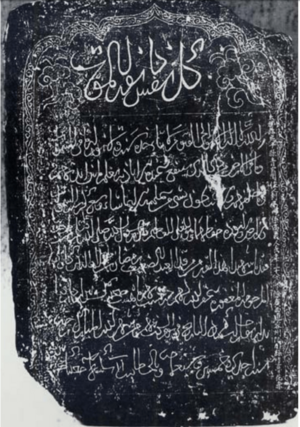Ramadan ibn Alauddin facts for kids
Quick facts for kids
Ramadan ibn Alauddin
|
|
|---|---|
| Born | 1312 or January 1313 Korea?
|
| Died | 11 April 1349 (aged 36–37) Rongzhou, Guangxi Province
|
| Nationality | Goryeo |
| Other names | 剌馬丹 Lámǎdān |
| Occupation | Darughachi |
| Known for | Being the first named Muslim from Korea |
Ramadan ibn Alauddin (born 1312 – died April 11, 1349) was an important governor during the Yuan dynasty in China. He was a Muslim and came from Goryeo (which is now Korea). He worked as a darughachi, which was like a local governor, in a place called Luchuan Prefecture. This area was in Guangxi Province, China.
Ramadan served as governor until he passed away in 1349. We know about him only because of a special stone carving, called an epitaph. This epitaph was found in a cemetery in Guangzhou, China. Ramadan is famous because he is the first Muslim from Korea whose name we know. It's not clear if he was ethnically Korean or if he was from another group who lived in Korea.
Contents
How We Learned About Ramadan
Discovering a Historical Figure
The first time experts wrote about Ramadan was in 1989. Two Chinese historians, Yang Tang and Jiang Yongxing, found his epitaph. They wrote a paper about old Islamic stone carvings in Guangzhou. This was how Ramadan, a Muslim from 1300s Korea, became known to historians.
Ramadan's Story Becomes Popular
Ramadan's story became well-known in South Korea in 2005. A newspaper called Hankook Ilbo published an article about him. The article talked about Son Sang-ha, who was an ambassador for South Korea. He visited Guangzhou to see a copy of Ramadan's epitaph.
In 2006, KBS, a big TV and radio company in South Korea, made a documentary. This show was about Islam in Korea during the Middle Ages. Ramadan was a main focus of this documentary.
Ramadan's Epitaph
What is an Epitaph?
An epitaph is a special message carved onto a tombstone or monument. It tells us about the person buried there. For Ramadan, his life story is known only from his epitaph. It was found in the cemetery of the Huaisheng Mosque in Guangzhou, China.
Where the Epitaph Was Found
The epitaph was originally near the grave of Sa'd ibn Abi Waqqas. He was a Companion of the Prophet Muhammad. Many people believe Sa'd ibn Abi Waqqas died in China. Ramadan's epitaph has now been moved inside the Huaisheng Mosque building for safekeeping.
What the Epitaph Says
Ramadan's epitaph is special because it's written in two languages. The main part is in Arabic. Smaller words around the edges are in Classical Chinese.
The Arabic part of the epitaph is like many Islamic grave messages. It starts with a famous line from the Quranic holy book: "Every soul will taste death." Then, it includes the full "Throne Verse" from the Quran. After that, it shares some details about Ramadan himself:
- "The Messenger of God said long ago, 'He who dies in a foreign land dies as a martyr.'"
- "This grave is where Ramaḍān ibn Alāʼ ud-Dīn, having died, has returned. May God forgive him and have mercy upon him..."
- The Arabic text also mentions a date: the Islamic month of Rajab in the year 751 AH (After Hijra).
The Chinese part of the epitaph gives more specific information. It tells us Ramadan's address, his job, and the exact dates of his death and burial:
- Ramadan was from Korea.
- He lived in Qingxuangguan at Wanping Prefecture, near Dadu (which is modern Beijing).
- He was 38 years old when he died.
- At that time, he was a darughachi (governor) in Luchuan Prefecture.
- He died on April 11, 1349.
- He was buried on September 30 at Guihuagang, near the Muslim cemetery in Guangzhou.
Dates on the Epitaph
There's something interesting about the dates. The Chinese text says Ramadan died in April 1349. But he was buried in his current grave only in September of that year. The Arabic text is dated to September 1350 CE. This is a full year after his burial. This suggests that Ramadan's grave might have been moved. It also means the epitaph itself was likely written a year after he was reburied.
Who Was Ramadan?
An Important Person
Ramadan seems to have been an important person. He was a governor for the Mongol Yuan dynasty, which ruled China back then. He also had a home near Dadu, the Yuan capital city.
The local Muslim community thought he was important enough to be reburied near Sa'd ibn Abi Waqqas. Sa'd ibn Abi Waqqas is seen as the founder of Islam in China. Ramadan's epitaph was also signed personally and included many verses from the Quran.
Was He Korean?
We don't know for sure if Ramadan was ethnically Korean. After the Mongol invasions of Korea in the 1200s, many Central Asian Muslims came to Korea. They were called semu. They worked for the Mongol and Korean governments or were merchants.
These Muslims created a community in Korea's capital, Kaegyong. They built a mosque and had a lot of freedom for their culture and religion. The Mongols often chose semu people, but rarely ethnic Koreans, to be governors. So, Ramadan might have been a Central Asian Muslim who was born or lived in Korea.
However, Ramadan's home was in Wanping Prefecture, a suburb of Dadu. Many ethnic Koreans lived there in the 1300s. Sometimes, the Mongols also considered Koreans as semu. They did sometimes appoint Koreans as officials and governors. So, it's possible Ramadan was an ethnic Korean. He, or his father, might have converted to Islam and taken a Muslim name.


